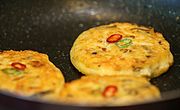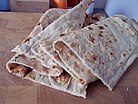food.wikisort.org - Dish
Bindae-tteok (빈대떡), or mung bean pancake, is a type of buchimgae (Korean pancake) that originated in the Pyongan Province.[2][3] It is made by grinding soaked mung beans, adding vegetables and meat and pan-frying it into a round, flat shape.[4]
 Bindae-tteok being fried in Gwangjang Market | |
| Alternative names | Mung bean pancake, nokdu-buchimgae, nokdu-jeon, nokdu-jeonbyeong, nokdu-jijim |
|---|---|
| Type | Buchimgae |
| Place of origin | Korea |
| Associated national cuisine | Korean cuisine |
| Main ingredients | Mung beans |
Food energy (per 1 serving) | 35 kcal (147 kJ)[1] |
| Other information | |
| Korean name | |
| Hangul | 빈대떡 |
| Revised Romanization | bindae-tteok |
| McCune–Reischauer | pindae-ttŏk |
| IPA | [pin.dɛ̝.t͈ʌk̚] |
Etymology and history
Bindae-tteok first appears under the name binja (빈쟈) in the Guidebook of Homemade Food and Drinks, a 1670 cookbook written by Jang Gye-hyang.[5] The word appears to be derived from bingjya (빙쟈), the Middle Korean transcription of the hanja word 餠𩜼, whose first character is pronounced bǐng and means "round and flat pancake-like food".[6][7] The pronunciation and the meaning of the second letter are unknown.[8] Tteok (떡) means a steamed, boiled, or pan-fried cake; usually a rice cake but in this case a pancake.
During the Joseon era (1392–1897), richer households would dispense bindae-tteok to poorer people gathered outside the South Great Gate of Seoul during times of hardship.[9]
Bindaetteok was often eaten in the northwestern part of Hwanghae-do and Pyeongan-do.[10]
Preparation
Bindae-tteok is made with the mung bean batter with a filling made of bracken, pork, mung bean sprouts, and baechu-kimchi (napa cabbage kimchi).[1]
To make the filling for bindae-tteok, soaked bracken is cut into short pieces, mixed with ground pork, and seasoned with soy sauce, chopped scallions, minced garlic, ground black pepper, and sesame oil.[1] Mung bean sprouts are washed, blanched, cut into short pieces and seasoned with salt and sesame oil.[1] Kimchi is unstuffed and squeezed to remove its fillings and excess juice, then cut into small pieces.[1] The ingredients are then mixed.[1]
Washed, soaked, and husked mung beans are ground with water and seasoned with salt to make the batter.[1]
The mung bean batter is ladled on a hot frying pan greased with a considerable amount of cooking oil, topped with the filling, and followed by another layer of the batter poured over the top of the filling. Finally, the bindae-tteok is topped with pieces of diagonally sliced green and red chili pepper.[1] The pancakes are pan-fried on both sides, and served with a dipping sauce consisting of soy sauce, vinegar, water, and ground pine nuts.[1]
Gallery
- Ingredients for bindae-tteok
- Pan-frying bindae-tteok
- Bindae-tteok
- Street food bindae-tteok
See also
- Pesarattu
References
- "bindae-tteok" 빈대떡. Korean Food Foundation (in Korean). Retrieved 25 May 2017.
- National Institute of Korean Language (30 July 2014). "주요 한식명(200개) 로마자 표기 및 번역(영, 중, 일) 표준안" (PDF) (in Korean). Retrieved 19 February 2017.
- 주요 한식명 로마자 표기 및 표준 번역 확정안 공지. National Institute of Korean Language (Press release) (in Korean). 2014-05-02.
- Gentile, Dan (28 February 2014). "Korean food: The 12 essential dishes you need to know from the North and the South". Thrillist. Retrieved 19 May 2017.
- "bindaetteok" 빈대떡. Korean–English Learners' Dictionary. National Institute of Korean Language. Retrieved 8 December 2016.
- Jang, Gyehyang (1670). Eumsik dimibang 음식디미방 [Guidebook of Homemade Food and Drinks] (in Korean). Joseon Korea. Archived from the original on 2019-01-12. Retrieved 2017-05-25.
빈쟈법
녹두 뉘 업시 거피여 되게 라 기 므디 아니케 부어 히고 젹게 노코 거피 에 라 소 녀코 그 우희 녹도 니로 더퍼 빗치 유지빗 치 지져사 죠니라 - "bindae-tteok" 빈대떡. Standard Korean Language Dictionary (in Korean). National Institute of Korean Language. Retrieved 25 May 2017.
- Unknown (1682). Yeogeo yuhae 역어유해(譯語類解) [Categorical Analysis of the Chinese Language Translation] (in Korean). Joseon Korea: Sayeogwon.
- Sturgeon, Donald. "𩜼 U+2973C". Chinese Text Project. Retrieved 25 May 2017.
- 정, 순자. "bindae-tteok" 빈대떡. Encyclopedia of Korean Culture (in Korean). Academy of Korean Studies. Retrieved 25 May 2017.
- "빈대떡". terms.naver.com (in Korean). Retrieved 2021-05-03.
Другой контент может иметь иную лицензию. Перед использованием материалов сайта WikiSort.org внимательно изучите правила лицензирования конкретных элементов наполнения сайта.
WikiSort.org - проект по пересортировке и дополнению контента Википедии




